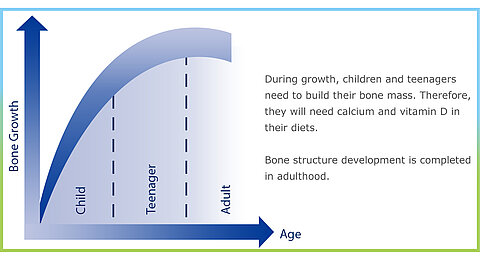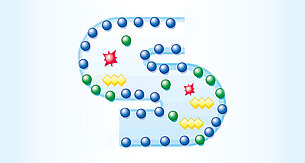Vitamin D for strong bones

Young children discover the world and get more active, day by day. Vitamin D is especially important for healthy development in the growth phase. Together with calcium, vitamin D plays a central role in bone metabolism and supports the development of healthy bones.
Vitamin D – the sun vitamin

Vitamin D is the only vitamin that our body can produce by itself in our skin. In order to produce vitamin D, though, the skin must be exposed to sunlight. This is where the name “sun vitamin” comes from.
About 80 – 90% of the required vitamin D is produced by the skin. Only 10 – 20% comes from food.
Young children who are protected by high sun protection factor (>SPF 15), the vitamin D store is not adequately filled up. It is possible that the vitamin D level may decrease further and further over time.
Although Vitamin D is essential for the absorption of calcium, in sunny Singapore, Vitamin D deficiency is rare as our skin manufactures Vitamin D in the presence of sunlight. So, it is good to let your child play outdoors daily for 10-15 minutes during the day to supplement his intake of Vitamin D from food sources. Apart from fortified milk, Vitamin D can also be found in liver, fatty fish like salmon, tuna and mackerel, egg yolk and fortified cereals.

Children and youths need to build up their bone mass while growing, as the body will never form as much bone mass as in the first 20 years. Only with strong bone growth in childhood, will the child be able to make full use of them as an adult.
Calcium and vitamin D are the most important for building up strong bones. Calcium is the building block for bones, while vitamin D plays an essential role in supporting normal development of bones and teeth. Vitamin D also plays a part in other metabolic functions in the body and also has an influence on the immune system.
This is why it is good to let your child to play outdoors daily for 10-15 minutes during the day to supplement his intake of Vitamin D from food sources.
Your child will continue growing and building up his/her bone mass long after infancy. Therefore, it is important for your child to receive exposure to sunlight as vitamin D remains essential all the way through their growing years.

We get vitamin D in two ways. Most of it is produced by the skin. The amount depends on the length and intensity of sunlight. Sun protection, covering the skin with clothes reduces vitamin D production.
In addition, food containing vitamin D can help in supplying vitamin D. There are, however, only a few foods that contain significant amounts of vitamin D. These include: fatty fish (e.g., herring, salmon, tuna). In liver, egg yolk and some edible mushrooms, the content is already considerably lower. On average, only about 2 – 4 µg of vitamin D is gained from food.
Tips for strong bones

Strong bones need to be built up from a young age, as the body never forms as much bone mass after the first 20 years. Anyone who regularly ‘invests’ in their bones at a young age, will benefit for the rest of their life.
What helps to make strong bones?
- Eating and drinking foods that contain vitamin D and calcium: Milk and dairy products contribute to calcium supply as well as fennel and broccoli. Fatty fish is an excellent source of vitamin D.
- Being active and building up muscles: The correct diet alone is not enough to build strong bones. Lots of movement is also recommended for building strong bones. This way, children can be introduced to exercise at an early age, e.g., with children’s gymnastics, and at the same time they are training their muscles in a fun way.
- Playing outside: Fresh air and sunshine is good for all of us. Especially outdoor games such as catch, jumping or ball games. They are fun and promote the development of healthy bones. Take advantage of the opportunity and play with your children outside! But please always ensure sufficient sun protection for prolonged exposure to sunlight.
Sources:
Thierfelder W et al. (2007) Biochemical measures in the German Health Interview and Examination Survey for Children and Adolescents (KiGGS). Bundesgesundheitsblatt Gesundheitsforschung Gesundheitsschutz 50(5-6):757-770.
2. Hower J (2008) Winterlicher Vitamin D-Mangel bei Kindern und Jugendlichen. Eine Praxisstudie aus Mühlheim an der Ruhr (51°N). Kinder- und Jugendarzt 8:552-555.
3. Kersting M (2008) Die Zufuhr von Kalzium und Vitamin D – Ergebnisse der DONALD-Studie. Kinderärztliche Praxis 79:296-299.
4. Deutsche Gesellschaft für Ernährung; Österreichische Gesellschaft für Ernährung; Schweizerische Gesellschaft für Ernährungsforschung, Schweizerische Vereinigung für Ernährung (DACH): Hrsg. Referenzwerte für die Nährstoffzufuhr - Vitamin D. 1. Auflage, 4. korrigierter Nachdruck ed. Frankfurt/M.; 2012.





